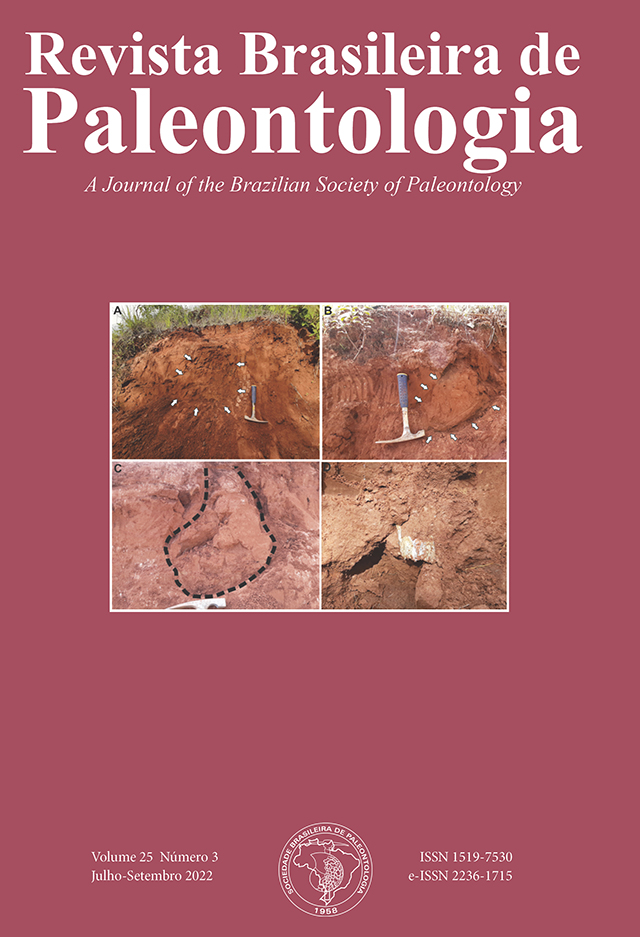Biostratigraphy and paleoenvironmental significance of Paleogene foraminiferal assemblages from Dashte Zari area in High Zagros, West Iran
DOI:
https://doi.org/10.4072/rbp.2022.3.03Resumo
The Paleogene carbonate deposits of Pabdeh and Jahrum formations are widespread from the northwest (Dashte Zari area) to the southwest of the Shahrekord region in the High Zagros Mountains of Iran and record the lateral and upward transition from open marine into the shallow water environment. The Pabdeh Formation shows a succession of open marine pelagic and hemipelagic limestone, argillaceous limestone, and argillaceous chert. It consists of planktonic wackestone, pellet-planktonic wackestone, mudstone with planktonic foraminifera, and radiolarian siliceous wackestone, which accumulated within the Zagros Foreland Basin. The planktonic foraminifers are assigned to the Late Paleocene–Late Eocene and correspond to subtropical and tropical Zones P4b–E15. The Jahrum Formation is represented by bioclast-bearing limestone and calcarenite. It consists of benthic foraminiferal wackestone, benthic foraminiferal-red algal packstone, and bioclast-intraclast packstone deposited in a shallow platform environment. The Jahrum Formation is inter-fingered in the upper part of the Pabdeh Formation and finally overlies it conformably during the Bartonian–Priabonian. Shallowing and off-lap relationships record basin shrinking, while repeated inter-fingering signals moderate tectonic subsidence. Both formations are disconformably covered by the Late Oligocene–Miocene Asmari Formation.
Keywords: biostratigraphy, Pabdeh Formation, Zagros, Paleogene, Iran.
RESUMO – Os depósitos de carbonato do Paleógeno das formações Pabdeh e Jahrum estão distribuídos do noroeste (área de Dashte Zari) para o sudoeste da região de Shahrekord nas Montanhas High Zagros, Irã e registram a transição lateral e ascendente de um ambiente de mar aberto para um ambiente de águas rasas. A Formação Pabdeh mostra uma sucessão de calcário pelágico e hemipelágico de ambiente marinho aberto, calcário argiloso, e chert argiloso. Consiste em wackestone planctônicos, wackestone pellet-planctônico, lama com foraminíferos planctônicos, e wackestone de radiolários, que se acumulou dentro da Bacia de Zagros. Os foraminíferos planctônicos são atribuídos ao Paleoceno Superior–Eoceno Superior e correspondem às zonas subtropicais e tropicais P4b-E15. A Formação Jahrum é representada por calcário bioclástico e calcarenito. Consiste em wackestone de foraminíferos bentônicos, packstone de algas vermelhas-foraminíferos bentônicos, e packstone de bioclastos-intraclastos depositados em um ambiente de plataforma rasa. A Formação Jahrum é interdigitada na parte superior da Formação Pabdeh e finalmente a sobrepõe concordantemente durante o Bartoniano–Priaboniano. Relações rasas e off-lap registram encolhimento da bacia, enquanto repetidas interdigitações sinalizam subsidência tectônica moderada. Ambas as formações são cobertas de forma discordante pela Formação Asmari do Oligoceno Superior–Mioceno.
Palavras-chave: bioestratigrafia, Formação Pabdeh, Zagros, Paleógeno, Irã.
Downloads
Downloads
Publicado
Como Citar
Edição
Seção
Licença
Copyright (c) 2022 Revista Brasileira de Paleontologia

Este trabalho está licenciado sob uma licença Creative Commons Attribution 4.0 International License.
This is an Open Access article distributed under the terms of the Creative Commons Attribution-NonCommercial-NoDerivatives license (http://creativecommons.org/licenses/by-nc-nd/4.0), which permits non-commercial re-use, distribution, and reproduction in any medium, provided that no alterations are made and the original article is properly cited. The written permission of Revista Brasileira de Paleontologia must be obtained before any commercial use and/or adaptation of the article.







